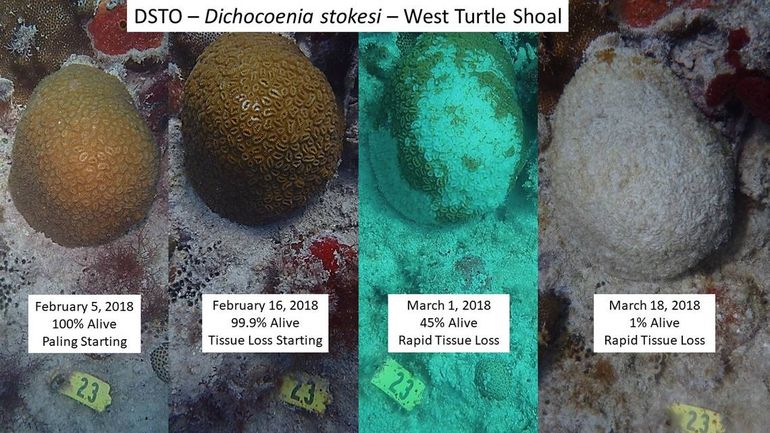
Sint Maarten’s coral reefs heavily hit by new disease
Dutch Caribbean Nature Alliance (DCNA), Nature Foundation St MaartenA new coral disease is spreading throughout the Caribbean region and kills off a large number of stony coral species. Stony Coral Tissue Loss disease was first reported in Florida in 2014 and has since expanded its range to include Mexico, Jamaica and the US Virgin Islands. Following monitoring by the Nature Foundation Sint Maarten in late October 2018, Sint Maarten is the first Dutch Caribbean island to report the presence of the coral disease on a number of local coral reefs, including within the Man of War Shoal Marine Protected Area. This is especially crushing news for the island whose reefs suffered extensive damage after being hit by Hurricanes Irma and Maria in 2017.
While the reefs in the region have suffered and recovered from coral diseases in the past, according to the NOAA Office of National Marine Sanctuaries Stony Coral Tissue Loss disease is proving to be “unprecedented in terms of its range, duration, and deadliness for corals”. Nature Foundation's follow-up surveys in early 2019 have found that anywhere between 50 and 90 percent of Sint Maarten’s stony coral has either been infected or has died.
The exact cause of the new coral disease is still unknown. Preliminary research points to bacteria as the main cause. Stony Coral Tissue Loss disease triggers the rapid loss of living tissue, with affected corals covered in white patches of exposed skeleton. Within weeks, the disease rapidly spreads outwards from the center of the colony until the entire colony is affected and eventually dead. The disease has a very high mortality rate of between 66 and 100 percent. For now we know that Stony Coral Tissue Loss disease affects approximately 20 species of stony coral, including reef-building star and brain coral species. Two species that are highly susceptible to Stony Coral Tissue Loss disease are the endangered elliptical star coral (Dichocoenia stokesii) and pillar coral (Dendrogyra cylindrus), although thankfully it does not affect the critically endangered reef-building elkhorn and staghorn corals.

Nature Foundation Sint Maarten is now pleading for help from the entire community to reduce the spread of Stony Coral Tissue Loss disease. There is still a lot of uncertainty surrounding the disease, but it is believed to be spread via direct contact and water circulation. Divers are advised to carefully clean their gear after each dive, and all swimmers on the reefs must pay extra attention not to touch any coral so as to not transmit the disease. Evidence also suggests that contact with plastic increases the likelihood of infection. This means that plastic pollution on local reefs must be removed, and littering and the use of single-use plastics minimized as much as possible. “The detected disease is an additional large threat to our coral reefs, and the Nature Foundation urgently needs the support of decision makers and the wider community to maintain what is left” commented Nature Foundation Director Tadzio Bervoets. “A sound wastewater infrastructure, holding those that dump wastewater in the ocean and wetlands accountable, increased monitoring, and a ban on single-use plastics and non-coral friendly sunscreen would go a long way”. In the meantime, Nature Foundation is monitoring the spread of the disease carefully and tests the application of epoxy mixed with antibiotic powder to see if it halts the spread of the disease on an infected coral colony. The Foundation is also creating extra reef habitat as part of the One Million Coral Initiative.
A new guide to help Caribbean marine natural resource managers to detect and manage Stony Coral Tissue Loss Disease was released by MPA Connect in February 2019. Early detection is crucial to treat and restore affected reefs. The guide includes technical knowledge to help identifying the presence of the disease and practical steps that managers can take to prevent further spread. This includes monitoring of highly susceptible coral species, disinfecting survey tools, informing relevant stakeholders, applying best MPA management practices and properly managing ballast and waste water from ships. Networking with other marine resource managers in the Wider Caribbean region will also be key in managing the spread of the disease; a regional monitoring program has already been initiated by Mexico.
More information:
Look at the MPA Connect's guide to detect and manage Stony Coral Tissue Loss Disease for more information.
Text: Florence Depondt, Tineke van Bussel, Olivier Kramer, DCNA; Tadzio Bervoets, Melanie Meijer zu Schlochtern, Nature Foundation Sint Maarten
Photos: Florida Fish and Wildlife Conservation Commission & Melanie Meijer zu Schlochtern, Nature Foundation Sint Maarten
